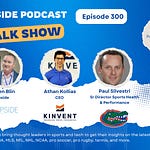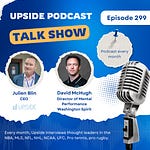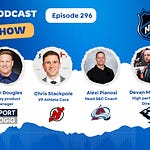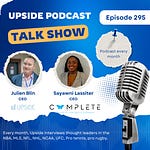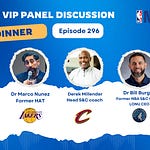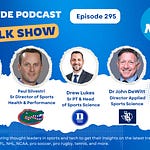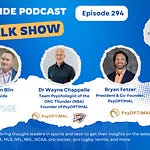This week, we have the honor to interview Garrett Salpeter, founder and CEO of NeuFit, known for the Neubie device, a direct current device used by many pro teams, universities and private clinics around the world.
Founded in 2009, NeuFit is a leading provider of direct current (DC) therapy equipment, helping people rehabilitate and recover through advanced electrical stimulation therapy. Founded in 2017 by CEO Garrett Salpeter the company has also assisted physical therapists, chiropractors, and other professionals in growing their businesses by offering the benefits of the NeuFit system.
Picture: Neufit’s Neubie
Here is a video explaining what the NeuFit method is:
Neufit’s Neubie is currently being used in 315+ practices & clinics, and by 2,200+ certified practitioners, 13+ universities (NCAA), and 17+ Pro teams (MLB, MLS, NHL, NBA, NFL..).
The Neubie is also been used by top athletes such as Mike Tyson (Heavyweight champion), Saquon Barkley (NFL) and John Isner (Pro tennis player).
Here's a video of Saquon Barkley (NFL) using the Neubie:
Here is a video with a testimonial from heavyweight boxing champion Mike Tyson using the Neubie:
📝Show Notes: Through this interview, we touched on his background, his role, his company and product, the benefits for sports organizations to use his product. We also talked about his plans for the next 12 months.
🚀Best Quotes: Here’s some of the key discussion points and best quotes from our conversation with Garrett:
On his background:
“So I'm very fortunate because I feel like I have found an area where all of my interests overlapped. My academic training is in engineering and neuroscience, and those are two big themes here. And then the initial catalyst for this was really an experience I had back when I played college ice hockey and I had several injuries along the way and I was very frustrated, disenfranchised with traditional physical therapy, orthopedic medicine until I had this experience where I had some torn ligaments my last year in college”.
On how he got the idea of launching NeuFit:
“I was supposed to be out for a few months and have surgery, and I met a doctor who was practicing functional neurology and using an older version of direct current, an analog device with knobs and dials on it. And I went through the process of working with him and the functional neurology piece and I was looking at the software and the function of the muscles instead of just the area that was damaged, the injured tissue, and then the direct current and these electric field gradients”.
“I saw how that helped me heal and going through this experience. I healed my ligaments on my own in two and a half, three weeks, and I avoided surgery. And I was so excited as an athlete, but also as an engineering student, to be able to find something that made sense from first principles. That's what got me really excited”.
On how he ended up launching NeuFit:
“So towards the end of my time in college, I ended up doing graduate school at the University of Texas in Austin, Texas, with the Longhorns. And while I was there, I met the chiropractor who takes care of the football team, and I ended up starting a practice at a room in his office of his private practice and started using older analog direct current devices”.
“And over about seven or eight years, I kept making great progress. But also, due to my engineering background I kept seeing ways to improve the technology. And long story short, finally just one day I said, you know what, no one else is coming out with it. I need to do it”.
On his Direct Current product and how it works:
“People will see this device and say, oh, that must be a TENS unit, or that's a Russian stem because that's most of the electrical modalities out there. And in an otherwise crowded field, why do we need another electrical stimulation device?”.
“And the answer is that there is a big difference in using direct current or DC as opposed to alternating current or AC and DC has these really unique properties that allow us to accelerate healing, to improve the rate of neuromuscular reeducation”.
“And it really is different than virtually everything else that's out there. Alternating current devices came into favor because although the benefits of direct current historically were known by the Soviets in the sixties and seventies it fell out of favor because it would have this issue where when you turn it up to a high enough level, it would burn the skin”.
And I could see that they could do it from Russia, but we couldn't do that over here in the United States. So we figure out a way to do it and to bring it here into the States basically. So we figured out a way to get those higher therapeutic levels of direct current into the body, but without burning the skin”.
On the health benefits of DC with the comfort of AC:
“One benefit is this direct electric field gradient. If you get a gradient, it's like if you have a hill, a ball that will roll down because of gravity. If you have an electric field, it acts like a gradient where charges will move just like a ball rolling down the hill. And so it basically can cause cells to move in such a way that it helps with the healing process for bone, muscle, connective tissue nerves”.
“And so it supports and optimizes the long-term healing process. But the other benefit is probably what we're even better known for. And that is helping over 90% of patients and athletes notice progress, make tangible progress in their first session on the device.
And so that's the neuromuscular reeducation side. That's the functional piece. And in as little as 10 minutes on the machine, we know it's far too quick for any tissue healing or regeneration to take place. So what we're able to do is this mapping process where you can scan around and identify where the nervous system is guarding, bracing, inhibiting, protecting, has hypersensitivity from c-fiber activity, whatever it is”.
“And a lot of times with injury, with pain recovering from surgery, it's not as much about the the original insult as much as it is that neurological response. And this allows us to identify exactly where that neurological protective patterning is being imposed on the body, focus on where you need to be focused on the treatment basically”.
On how the Washington Nationals (MLB) ended up using and loving about his product:
“One of the biggest things we hear is that the players love it. We had a first team that got it, the Washington Nationals (MLB). They won the World Series back then. They got it, they used it that whole season and they had a line of players that were using it. One actually, who isn't there anymore, Anthony Rendon, had some back pain”.
“And he had to miss time here and there and thought he would've to miss time at the end of the regular season. And in just two or three sessions he got out of pain. It helped him so much that he started using it for his movement prep and activation before games. So he'd put it on when they were working with him, they did the mapping and they found hotspots for him”.
“He had something in the adductor and something in the oblique, probably very logical for a rotational athlete. And he would then continue to use those same spots, put it on for three or four minutes before going out to play. And he just felt loose, he felt great. And then their pitchers in position players would do that as well”.
“So they'd have a line of eight to 10 players that were just doing self-serve, go put it on, and do a few minutes of movement prep work beforehand. And then the general manager came in and wanted to get treated and the line was too long. So he actually cut through the red tape and ordered the second one more quickly”.
On the various use cases how his product is being used by teams:
“So the use use cases are definitely acute injury, whether it's an AC sprain, ankle sprain. It could be back spasms. We have a lot of different acute cases. And then post-op, I was just on the phone actually before this with a surgeon for an NHL and NBA team who used it in his private practice and with a lot of players talking about different applications”.
“Then outside of rehab, there are applications, there's a vagus nerve, what we call our master reset, a parasympathetic protocol. That's a passive one where the players are able to leave it on, and we see a big increase in heart rate variability”.
“You'll see some of that if you just do some guided breathing. But if you do guided breathing with this, that increase in heart rate variability will be 3, 4, 5 times bigger. And that can help with recovery through just the grind of the season when athletes are having trouble keeping up with all of this, all of the travel, the issues with meals, the circadian rhythm disruption, not to mention actually practicing, playing, competing, all that stuff”.
“So recovery, movement prep, and then there's a training effect. So sometimes we have a couple of NBA players, for example, that want to get good eccentric loading on their quad muscles to help with knee tendon health but don't necessarily want to do a lift or a lot of weights in the season”.
“So we worked out with them a routine where, after a game, it'd be 10 pm or 11 pm in the evening after a game, they'll do just a few minutes on a more strength setting here so they can get a lot of load muscle recruitment using the device. As if they're lifting weights, but without having to load up, and they'll do just some body weight exercises for five or 10 minutes and they'll get that eccentric loading on the quad”.
“And then they'll do that on days where they're not playing back to back. So they have 24 to 48 hours to recover from that and kind of integrate it and be ready to play again, because that could be fatiguing. So it depends on what your goals are, but recovery, rehabilitation recovery training, there's all applications there. And the reason it's so broad, is that we're working with the nervous system and so it's relevant for so many things”.
On the teams in the MLB, NHL, NBA, NCAA using his product:
“For you and your audience here, we can at least talk about some teams. In the MLB, a few of the last World Series champions are using them, the Washington Nationals, the LA Dodgers, then the LA Angels, the Chicago Cubs. That was fun for me because that was my hometown team growing up there to train their staff”.
“In the MLB, we also work with the Rays, the Phillies. And in total we work with about half of the MLB league now, about 15 Major league baseball (MLB) teams are using it”.
“In the NFL, we have several teams such as the Seahawks who are using it now. The Jets and the Tampa Bay Buccaneers have had it for a few years. The Panthers, and Commanders are using it too”.
“In the NHL, the New Jersey Devils are using it as well. We're talking to them right now because they're actively in the playoffs, so we're just supporting them a little bit”.
“In the NBA, the LA Clippers are using it. We have a good mix of teams using it and for a lot of different use cases. In the MLS we also work with the Austin FC here, our local team. We also work with the St. Louis City SC, and Columbus Crew. In the NCAA we have, for example, the University of Texas. In fact our Head of Sports Medicine actually was a full-time PT at the University of Texas Longhorns and now he is with us in our private practice, but he also still treats athletes at UT, including using the Neubie, and then Ohio State Football and another handful of universities, are using our product”.
On his business model:
“So it's typically a capital expense. You can just buy it and use it as much as you want, and we have a warranty and everything like that. But you can use it. We'll train you on how to use it, and there's no ongoing subscriptions or requirements to pay. You can choose to buy electrodes from us. We pass along wholesale savings to people or you can, even buy your own. They don't have to be proprietary, but a lot of teams like that because they don't have to worry about getting approvals for ongoing expenses or they don't have to buy time on the device or anything like that. They can just buy it and use it depending on how the budget goes”.
“With some teams, we have worked out arrangements where they can make payments so it can come out of one budget instead of another. And it's not as big of a CapEx thing. But it's typically including the training and the warranty and everything”.
“Typically, it starts at $18,000 and then for multiple units and it comes down in that $15,000 range. Teams typically get it approved as a capital expense, capital investment”.
On their plans for the next 12 months:
“So one big area of focus is research. We have a PhD neuroscientist who runs our research program. And one of the biggest studies we have gone now a little bit outside of the realm of athletics, but we are working with neuropathy patients and actually part of the reason it's exciting is that we're seeing nerve regeneration even in patients in their seventies who have diabetic neuropathy when it's been written off that they might ever heal or have any meaningful improvements. So that's been exciting”.
“We're also working with a large orthopedic group in Columbus, Ohio, looking at outcomes for older patients with total knee replacement, but more relevant here we are looking at athletes after a ACL reconstruction, and we're seeing that they're reaching their functional milestones faster and having all these wonderful outcomes and patient satisfaction is going up and, and everything there is super positive”.
“We also just published one of our first scientific journal articles, actually the first two are on the effects of the neubie creating muscle hypertrophy without any external weight at all, similar to 75% to 80% of one rep max. So we're seeing, seeing benefits there. So research is a big one”.
“We are also working on some new product developments. For example we are working on ways to miniaturize that and we've made some really good headways on being able to create our waveform with that smaller form factor, which is a really deep breakthrough. And so we just made our first deal with a professional team where we made a deal with them so they could buy this current version now, and then the next season they would have a lock in at a very inexpensive upgrade price for the new unit”.
On the best way to to reach out to him:
“The best way to reach out to us is probably through our website. So please go to www.neu.fit or you can email me directly at garrett@neu.fit”.
You may also like:
🔥 Upside Chat: Dave Hancock, CEO, Apollo (Leading Athlete Management Systems (AMS) vendor)
🔥 Upside Chat: Dr Andy Barr, Consultant, Brooklyn Nets (NBA) & Quantum Performance Founder
🔥 Upside Chat: Ismael Fernandez, ThermoHuman CEO
🔥Upside: AMS Ecosystem Analysis: Key Trends, Vendors and Recommendations to Teams
💦Upside Analysis: The sweat and heat sensing market (Key Trends, Vendors)







